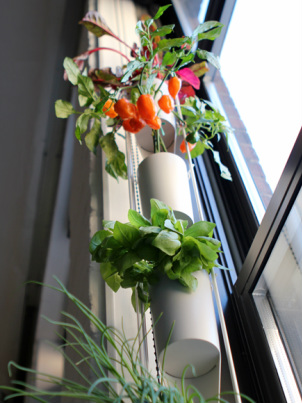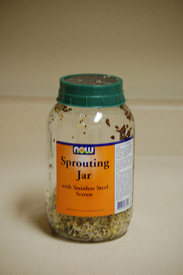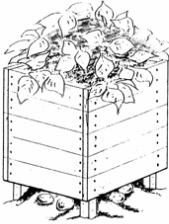Standard Gardening Simple garden.
Standard gardening is simple plotting. Clear the first 3 inches of grass and sod to expose the rich black soil underneath. Work this cleared area with a shovel or a hoe until the earth is turned over well for at least 6-8 inches in depth. This process should actually be performed in the fall before your spring seeding and then repeated again in the spring before planting. You want to break the soil up well to the point that you can run your open hand and fingers through it and the dirt will fall through your fingers easily. The finer the soil is separated and broken down the more the air can circulate through it as well as providing better water retention. Now look on your seed packet for further instructions for your preferred choice of vegetable as far as to climate, depth of seed, season of fruiting and water needs. Some things are planted late and some are planted early, if you do the math and work it out, you can have fresh food 6-8 months out of the year.
Find your basic and beginners resources here at MOVOTO and check out our "LINKS" page as well for more resources. The Gardeners Calendar is another good source. |
|
The New - Old Raised Bed or (hugelkultur)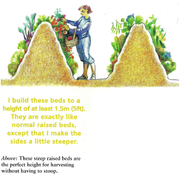 Mound Garden
A man named Sepp Holzer has emerged to the fore front of raised bed gardening and if this is something you are planning on doing you should study his works. It is a little more labor intensive in the beginning but in the long run it is a far better system. This system is not a new one, Europeans have used this form of growing for centuries, it is also known as hugelkultur or mound gardening. It mimics the natural processes found in nature. The idea is to pile old degrading wood in a small mound and covering it with soil like you find on a forest floor, as the wood naturally deteriorates and releases nitrogen it feeds the vegetation as well as allowing oxygen to circulate more freely and water to thoroughly penetrate the root system as it is held in the wood and slowly released.
Making a Hugelkultur Bed Sepp Holzer |
|
Terrace Gardening
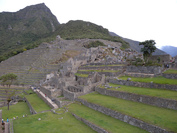
Ancient Terrace farm
Terraces are series of levels on a hill side. The levels are leveled to flat surfaces and separated by elevation points in a step pattern with the lift of the hill side. The levels are separated by walls that work their way up the incline horizontally to the hill side. The walls (usually made of stone ) help to capture water and irrigate the plots or even in some cases the plots are flooded to grow grains like rice or they can just hold water at the top to be released at a later point in time to the lower levels. This is an ancient form of farming derived from necesity in mountainous regions where there is a lack of flat ground to grow, but it most definitely has its advantages over traditional field farming and its disadvantages like you have to walk up hill.
Straw Bale Gardening
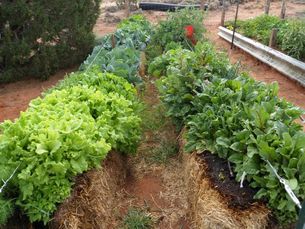
When I first heard about straw bale gardening I called Shenanigans on it and held my head high in disbelief as I walked back to my truck to drive away and then race home to my computer. Sure enough there it was in all its glory and simplicity, how had I not heard of this before, Growing in straw, I couldn't believe it, but if you think about it, it couldn't make more sense. Lets start with the PROS, right off the bat your garden is higher off the ground so that means less bending and no digging, straw produces heat naturally, so earlier planting, and even earlier planting then that if you incorporate a plastic cover to trap the heat from the straw. very little if any weeds, high moisture retention, Nutrient rich and so on.... CON's-The straw does not provide all the essential nutrients needed for plant growth like soil or a premium potting mix does, so straw bale plants need to be fertilized once a week using a water soluble garden fertilizer containing nitrogen, phosphorus, and potassium and micronutrients. The oldest leaves of vegetable plants turn yellowish if they are deficient in nitrogen. Anything you can grow in the ground you grow in a straw bale. This is great for growing potatoes too, at the end of the growing season you just break the bale apart and pick up your taters. This technique is especially beneficial for the elderly and less abled garden lovers, it cuts the back breaking work in half if not more.. Find a PDF on the basics of Straw Bale Gardening in our >LIBRARY<.
Here are some links and resources. Straw bale Gardens Modern Farmer Wiki How |
|
Aquaponics
This is the future of food sustenance Acuaponics system
Aquaponics is the gardening of the future, No weeds, no bugs, no critters. This type of gardening is a symbiotic meeting of hydroponics combined with aquaculture and produces yields that are higher and grow faster and also provides fresh healthy fish to be harvested. When the two systems are combined there is no need for chemicals and disease is uncommon. The fish produce ammonia that is converted into nitrogen for the plants to eat that in return give off nutrients to feed the fish. This field has come along way and is viable on all levels and in all sizes, a productive aquaponic system can be set up in two 50 gallon barrels and produce a plethora of food year round and you don't have the back breaking soil work to do. Aquaponics uses 95% less water then alternative farming, You can grow up to 60% more vegetation in the same space and in less time then a conventional garden. Go to the Offgridding LIBRARY and down load the "BarrellPonics" pdf under the Growing section to see how easy it is, this will provide you with a simple backyard set up that you can do.
|
|
Bio-Domes and Green Houses
Taking gardening into the next level. Bio-Dome
Bio Domes and green houses basically work on the same principle, They allow the suns light to pass through them and capture the heat in side. The difference in temperature from the out side to the inside can be quite drastic, 20-30 degrees in some cases depending upon the design. They also help to prevent frost from setting on the vegetation allowing for a longer growing season in the case of a green house. Bio domes on the other hand allow for year round growing, the vegetation thinks that it is summer all of the time because of the warm temperatures you are able to sustain through different processes. The father of the bio-dome is a man named Buckminster Fuller. Bio-Domes are more about creating a symbiotic Eco systems that runs the gamut from fertilization to harvest all being created in one circle of growth and decay that just keeps repeating itself including the use of fish tanks to neutralize the water and the fish can later be harvested for food once they breed more fish and reach the proper size. The fish mostly used in this situation are catfish and tilapia which are easy to raise and are hardy and full of protein.
|
|
WINDOW FARMING
URBAN FARMING, Window farming,Microgreens and sprouts. Perm-urban-Culture Bottle Garden
I don't have room to grow things, I live in the city. "NOT" . You can grow strawberries in a water bottle or herbs or carrots or sprouts all in a 4 inch square area, you can grow a salad on a windowsill. It's amazing what will happen when you put a seed in soil an give it some water and a little light, it knows what to do and the first thing it will do is look for sunshine and then it will reach for it and bear its fruit along the way. Here are some good ideas to grow things in small spaces or even just to get your feet wet and your fingers dirty and try it out. Once you see your creations come to fruition, you'll be hooked on growing and you'll be hooked on life.
Check out some of these links for some good ideas. NPR story window farming. Window Farming Urban Gardner Microgreens Tower Gardens |
|
GROW LETTUCE IN A CUP

I couldn't believe what I saw on Facebook a couple weeks ago—lettuce growing in a glass of water. I had to try it. The instructions specified that one should cut off all lettuce leaves from a fresh head, leaving an inch-or-two stem, and put it in an inch of fresh water in a bright sunny window. This works only with lettuces that form a round head or cone at maturity, not leaf lettuces. (READ MORE) : From the Farmers Almanac
Because you live in the city, isn't an excuse.
One-Straw Revolution BY: Masanobu Fukuoka.
Natural Farming. Down load this free PDF of one mans journey into the future of the past. >PDF< |
Permaculture Design Course. |
Pick your own |


